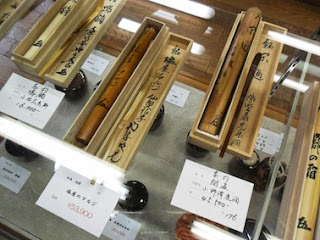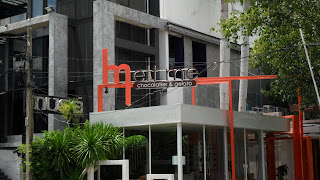Jike Hometown Village 寺家ふるさと村 [Jike furusato mura] -- Part 2
A visit to an agricultural village for a lecture on sumi (charcoal) in Kanagawa, continues.
Part one is HERE.
Our group arrived at the main destination for the morning: the sumi house, where we would partake in a lecture on Japanese charcoal.
Outside the sumi house:
This is the kanji character for sumi (charcoal):
Inside, I was surprised to find on display, numerous items which are used in sadou (Japanese tea ceremony). The prices were unbelievable too.
Some women in the group explained these pots are used to hold water during the ceremony:
Detailed close up of one pot:
 |
| This pot is about $600. |
 |
| The price tag says ¥91,000 or $910. |

These hold spoons or ladles used in the ceremony:

These are chawan (lit. tea bowls). In a traditional tea ceremony, tea is not served in cups, but in a bowl like those below. The bowl is usually a handcrafted, decorative piece of pottery and should be viewed as artwork. As it is considered art, these bowls are usually very expensive.
Sadou chawan:
 |
| The price tags say: $2,225 and (I think) $3,500. |
 |
| The most expensive price tag says: $539. |
Here is a complete sadou set, where you can see all the pieces:
Studying the tea ceremony in Japan is possible. Many culture centers and private teachers offer lessons. If you are interested in studying, just as a student, it's not expensive; however, if your goal is to become a teacher of sadou, I was warned -- the costs are high.
I'll show more photos from inside the sumi house next time. The owner specialized in creating unique sumi ikebana (charcoal flower arrangements). They are so unique! See you soon. ^_^
~Information~
Sumi House is located in Jike Furusato Mura in Kanagawa. Map is HERE. (Japanese only)
Access:
-- Den-en-Toshi line to Aoba-Dai Station. Take city bus #30 or 31 to "Shike no Ie" stop. (about 15 minutes). Walk to the village (220 meters).
You can learn everything about the Japanese Tea Ceremony HERE, including its history, tea making equipment, etc. (via Japanese Tea Ceremony.net)
Interested in studying tea ceremony? HERE is a list of places to learn (America, Belgium, other countries are listed)
Coming to Japan? Would you like to witness an actual traditional tea ceremony? THESE PLACES offer the ceremony with English translations. Let's enjoy Japanese culture! (via Japan National Travel Organization)







Comments
Post a Comment